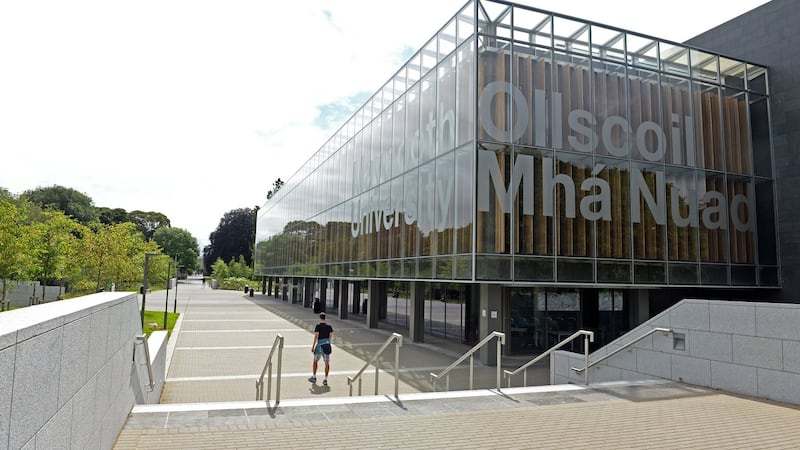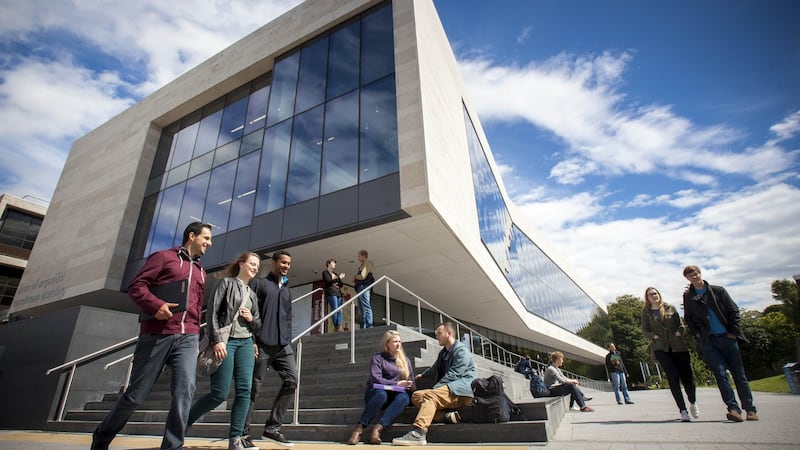Dublin City University
What they use:
A range of digital tools and platforms as part of Loop, with Moodle at the core. Zoom for live teaching, Mahara for eportfolios and Unicam to support video and rich media learning.
What has changed since 2020:
Distance learning was built into DCU's DNA from the very beginning, long before the internet arrived in Ireland, which helped the university when moving its courses online due to Covid-19.
DCU has designed, developed and delivered a free online course, "Teaching Online", through the FutureLearn platform; so far, over 90,000 educators from around the world have joined the course.
What's unique:
With more than 35 years' experience in the design of online distance education, DCU hosts the National Institute for Digital Learning and, last year, hosted the World Conference on Online Learning.
Also through DCU's strategic partnership with FutureLearn over 8,000 students worldwide have taken our free course, A Digital Edge, on learning how to learn online. The university offers fully online courses and degrees through DCU Connected and partners with institutions, such as Arizona State University, one of the world leaders in online education.
Plans for 2021:
A number of cross-faculty initiatives, introduced during the pandemic, will be retained. These include interactive oral assessments, flipped classrooms and a programme from Dr Sarahjane Belton of DCU's School of Health and Human Performance and Dr Stephen Belton of SFI's Insight Centre for Data Analytics which ran an excellent initiative recording short exercise videos; it received more than 60,000 hits and helped keep school kids active during lockdown.

Maynooth University
What they use:
Moodle and Microsoft Teams
What has changed since 2020:
The university has scaled up its resourcing and support of Moodle to handle larger volumes of user content and access and to enable greater facilitation of assessments and exams, as well as introducing Panopto, a video recording solution for live streaming and recording lectures.
Digital technologies can help students to participate more flexibly and widen participation, a spokesperson says.
What’s unique:
The university has established a partnership with Maynooth Students’ Union in order to ensure that the student voice informs its online teaching practices. As part of this work, student interns have created a range of resources “by students, for students,” aimed at supporting online learners.
Plans for 2021:
On-campus and in-person activity is central, but aspects of online teaching and learning will remain. Digital technologies have proven particularly effective in facilitating a flipped classroom approach, for example, where content can be uploaded in advance and in-person time can focus on more interactive, engaged teaching and learning.
The university, in consultation with the Department of Further and Higher Education, Research, Innovation and Science, is planning for a number of different scenarios.
Munster Technological University
What they use:
“At the core of a feature-rich digital learning ecosystem, we have a virtual learning environment, or VLE, which provides a range of features for learning functions such as assessment, content sharing, collaboration and class management,” a spokesperson says. A live elearning platform which supports live classes, labs and other real-time interactions is built into this platform.
What has changed since 2020:
MTU has had fully-online and blended programmes for several years. Staff have worked to ensure continuity during the pandemic and will emerge with a new repertoire of skills that benefit their students.
What’s unique:
"We continue to partner with research centres and universities across Europe and beyond in investigating new trends and opportunities in the [digital and online learning] work which feeds into the ongoing evolution of our mainstream services and supports," says the spokesperson.
Plans for 2020:
MTU has a range of hybrid options that can be rolled out in the event that students don’t make a full return to campus.

NUI Galway
What they use:
Blackboard for most online content, student assessments and exams.
What has changed since 2020:
Students with disabilities have felt more a part of the overall class.
“We’ve also seen many staff and students use Microsoft Teams and Zoom, or produce pre-made video content hosted on our Kaltura video system, with increasing numbers of staff developing interactive content using H5P,” says Dr Iain MacLabhrainn, director of the Centre for Excellence in Learning and Teaching at NUIG.
What’s unique:
“One of the success stories, which has helped considerably with student wellbeing, sense of belonging and academic success, has been our peer-assisted learning scheme, Céim,” says MacLabhrainn.
“This has been running in the university for a number of years, but what has been impressive to see is the way in which the organisers quickly adapted it to an online mode, with huge amounts of preparation and training happening during last summer in advance of the new academic year.”
Plans for 2021:
Uncertainty remains, with the university planning for a number of scenarios involving hybrid teaching and blended course offerings.
Beyond Covid, video materials, interactive tools for lab and practical work, and different exam approaches may remain.
Technological University Dublin
What they use:
Brightspace and Moodle, as well as new multimedia content editing software and a polling tool which will be in place by September.
What has changed since 2020:
"TU Dublin has designed a new checklist for staff to provide practical recommendations to guide the further development of online modules in TU Dublin's virtual learning environments," says Dr Jennifer Harvey, head of the Learning, Teaching and Technology Centre at TU Dublin.
What’s unique:
A range of supports, including peer mentoring, will be extended to second-year students in the 2021-2022 academic year. A student skills-for-success portal has been developed to assist students in preparing for university and becoming effective online learners. And staff have been supported through new communities of practice to encourage them to develop and exchange practices concerning AR/ VR, authentic assessment and assistive technologies.
Plans for 2021:
“The pandemic has been a catalyst for change in every sector, and the third-level teaching and learning landscape is adapting, drawing on the best of the online and physical worlds,” says Harvey. “TU Dublin will conduct a review of hybrid-flexible (HyFlex) course design options across a selection of programmes in the coming academic year. This approach delivers student-directed multimodal learning experiences that give students a choice to attend sessions in the traditional classroom or participate online, according to need or preference.”
Trinity College Dublin
What they use:
Different courses use different tools and programmes, but the primary options include Blackboard (including Collaborate Ultra), Zoom and Microsoft Teams.
What has changed since 2020:
Trinity has, in many cases, used a flipped classroom approach, in which students engage with some content and prepare before attending their lectures. Some students are more comfortable asking questions in the virtual classroom than they might be in a packed lecture theatre, while recorded lectures are also useful.
What’s unique:
Trinity is working to ensure the student voice is heard in relation to online learning, teaching and assessment approaches. For example, Trinity Teaching and Learning has partnered with students to develop an online hub called Gateway to Digital Assessment.
Plans for 2020:
The university plans to retain the positive aspects of online learning. “The move away from traditional exams and towards online open-book exams has been positively welcomed by students who feel that open-book exams give them opportunities to apply their knowledge across a range of real-world contexts,” a spokesperson says. “More routine use of technology in face-to-face teaching is likely to persist and large-group lectures may not be quite the ‘norm’ that they previously were.”

University College Cork
What they use:
Canvas, which saw a significant increase in usage with more than 8,500 courses used by more than 2,000 teachers. Panopto usage increased, while the university also uses MS Teams for collaboration and video conferencing and the full suite of MS Office 365 tools and Google education apps.
What has changed since 2020:
“Support was ramped up with central services such as the Centre for Digital Education and IT Services delivering on-demand training as needed in the application of technology to education,” says Tom O’Mara, head of digital education at UCC. “Online resources were frequently updated including an online interactive course, weekly webinar and various websites with information. A new MS Teams “Teaching with Technology” support service was introduced.
What’s unique:
A 24/7 dedicated helpline and chatline for students and staff, with help on how to create Canvas content, how to set up a discussion forum and how to submit an assignment in answer to an exam question.
Plans for 2021:
“The focus is on taking stock of what worked well online and what is better served by being delivered on-campus,” says O’Mara. “We expect that the future is very likely to be blended for most disciplines.”
University College Dublin
What they use:
Brightspace, chosen for its range of user-friendly tools including easy to access calendar, announcements, discussions and notifications, as well as a VLE.
What has changed since 2020:
UCD conducted in-depth surveys to assess how students were coping during Covid-19. Missing and making friends, sustaining concentration and dealing with loneliness all arose, but in spite of this, the exam results indicated that the vast majority of students performed well in assessments.
The university has invested heavily in software and hardware to support digital learning.
What’s unique:
Since 2013, UCD has responded to home and overseas demand for flexible learning approaches, launching the UCD Online website to showcase a range of courses, which began with nine graduate-level, fully accredited courses including environmental sustainability, data analytics and food nutrition and health and now includes 22 courses. Students can study full time and complete the course in the minimum time allowed or enrol in a part-time pathway where relevant qualifying modules contribute to the final award.
Plans for 2021:
UCD welcomes recent statements from the Minister for Higher Education, Simon Harris, hoping for a substantial return to campus. But uncertainties mean that plans must be adaptable, and UCD has begun a planning process for 2021-2022, seeking to deliver as normal as possible an on-campus experience.
University of Limerick
What they use:
The institutional VLE is used for teaching, learning and assessment, with additional tools including Panopto for recording content and Microsoft Teams for all collaboration and events.
What has changed since 2020:
Higher-education institutions have adapted quickly in the past year. Dr Mary Fitzpatrick, head of the centre for transformative learning at UL, says that live or recorded lectures provide opportunities for engagement and discussion, as well as provide flexibility. Students seem more likely to engage in the VLE than the traditional learning experience.
On the downside, students can miss structure and sometimes feel isolated, as well as have difficulties with online group projects due to technology and broadband issues, she says.
What’s unique:
The student engagement and success unit provides advice and support to new students. UL also offers digital skills workshops and a learning technology forum which provides centralised support and professional development for all those who teach via webinars and resources on teaching, learning and assessment online.
Plans for 2020:
If third-levels remain restricted, the blended learning model would likely continue. End-of-semester exams have, where possible, been replaced with continuous assessment.
“Online learning, teaching and assessment would otherwise have taken years to develop, albeit through a steep learning curve” says Fitzpatrick. “It’s critical to consider what is effective.”
Waterford Institute of Technology
What they use:
Moodle is the virtual learning environment, Zoom for video conferencing and Microsoft Teams for instant messaging and communication.
What has changed since 2020:
Broadband access was a challenge for some rural students, so study hub places were made available on campus and in the library as restrictions allowed.
What’s unique:
“The institute of technology sector has historically had smaller class sizes and this has continued online,” says a spokesperson. “Smaller class groups that are encouraged to contribute and take ownership of their own learning has been a hallmark of how we have approached both online and on campus learning.”
Plans for 2020:
Like most higher education institutions, WIT says that some students have benefited from the increased flexibility offered by online learning, particularly part-time, postgraduate, executive and continuing-education students.
WIT is confident that it can quickly move online again if they have to. “We have learned a lot about what has and what hasn’t worked over the past three semesters,” WIT says.
Classhub
What they use:
Classhub.ie is a custom-built online platform where parents and students can search for and connect with tutors easily and securely. Lessons are offered to both primary and secondary students.
"Our 'online classroom' is equipped with useful tools such as seamless audio and video, instant messaging and screen/file sharing to enhance the overall remote learning experience for students," says Mark Dunne, founder of Classhub.ie. "Tutors can easily manage their schedules and bookings from individual dashboards, and all direct parent-to-tutor payments are facilitated securely online."
What has changed since 2020:
Learning shifted from in-person to online during the pandemic, but Classhub.ie can also help connect parents with tutors if in-person tuition returns.
What’s unique:
Students can access tutors from all over Ireland, and save time and money on travelling to meet them. Lessons cost about €25 or less, and students schedule as many or as few lessons as desired. Automated manual processes make the process easier for students and tutors, allowing them to focus on education.
What’s next?
Medium- to long-term, Dunne says that there will be a hybrid blend of in-person and online learning. “We’re continually developing and optimising our technology,” he says.

King’s Inns
What they use:
"Lecture software capture allowing students to stream back recordings of lectures; videoconferencing software to replicate the experience of in-person, interactive learning; and a virtual learning environment," says Dr Eimear Brown, dean of the School of Law at King's Inns.
What has changed since 2020:
In October 2020, King’s Inns hired a learning technologist to work with the educational team to help them more effectively use the college’s elearning technology. The college has a diverse student body ranging in age from early-20s to over-70s, so the material has to be accessible.
But Covid has highlighted the importance of the in-person social aspect, says Brown. “A lot of peer-to-peer engagement and collaboration happens outside of the class, in the corridors, breakout rooms and at social activities. attending the many social activities we offer throughout the year. During 2020-2021, we streamed the events live online and we found that attendance rose dramatically.”
What’s unique:
Guest lectures by judges and other legal experts continued, and because they saved time on travel, student engagement with legal experts increased.
What’s next:
Most advanced diploma courses will be mostly online, with the barrister-at-law course returning to in-person teaching, all subject to public health restrictions.
Solas
What they use:
Primarily Moodle, Microsoft Teams and Google Classroom.
What has changed since 2020:
“There is a huge appetite out there for flexible learning options,” says Ciara Ní Fhloinn, flexible learning manager at Solas. “Our eCollege fully online learning service has had more than 47,000 new joiners since it was opened to the public as an emergency response to Covid-19 in March 2020. Across further education and training we have seen a huge appetite for flexible blended and online learning opportunities across different economic domains.
What’s unique:
“Further education and training is all about learning the skills you need at whatever point in your life you need them,” says Ní Fhloinn. “We provide hands-on applied knowledge using virtual and blended tools, while also ensuring that learning opportunities fit around the busy lives of our learners. We focus on skills first, and use the best blend of technology and human support and encouragement, and we recognise that not everybody has access to devices or digital skills, so we have a range of learning options.”
What’s next:
“The flexibility of digital modes is something we will carry into the future, as it really fits into the further education and training ethos of accessing learning at whatever point in time you need it,” says Ní Fhloinn. FET is for everybody, and digital modes of delivery, combined with the support and encouragement of FET teachers, trainers and instructors, will enable the provision of more learning opportunities to more people in communities across Ireland.
IT Sligo
What they use:
Mainly Moodle for the virtual learning environment, Adobe Connect and Microsoft Teams for live classroom delivery.
What has changed since 2020:
IT Sligo has been teaching online since 2002 so, going into the pandemic, was probably the best-prepared and equipped of all the institutes of technology. “We’ve witnessed a great sense of comradery among our online learning community, something that is often underestimated in a virtual world,” says Prof Jacqueline McCormack, vice-president of online development. “We have students working collaboratively on projects from disparate parts of the country and globe, bringing together different life experiences, which ultimately adds to the learning experience.”
What’s unique:
Online supports include maths tutors, an academic writing centre, library services and virtual health and wellbeing services. Online student advisers are on hand to help students navigate their way through college life.
IT Sligo has a dedicated centre for online learning, for routes from level-six higher cert to level-nine postgraduate, and recently completed the first year of full-time online programmes for those who can’t attend class in person.
IT Sligo recently received HEA Innovation Fund support for the iNote project, which is being developed with Galway-Mayo IT and Letterkenny IT. "Our role has been to lead the development of a range of student support and wellbeing services designed for online learners," says McCormack.
What’s next:
IT Sligo’s 150 part-time courses will stay online beyond 2021, and the college is primed for growing online learning student numbers. But they’re hopeful of a return to campus for in-person learning.









